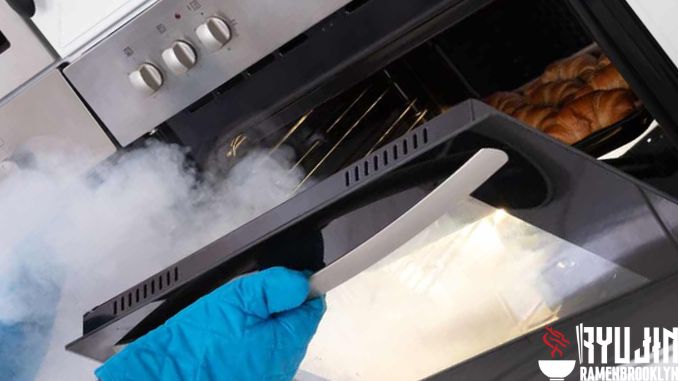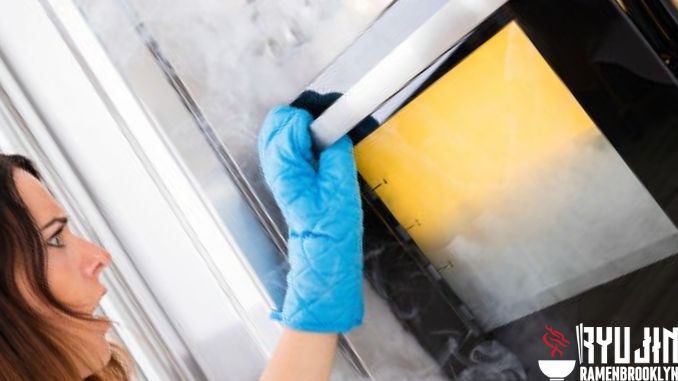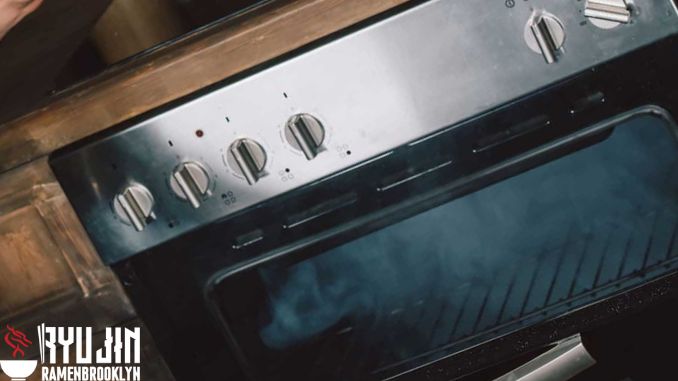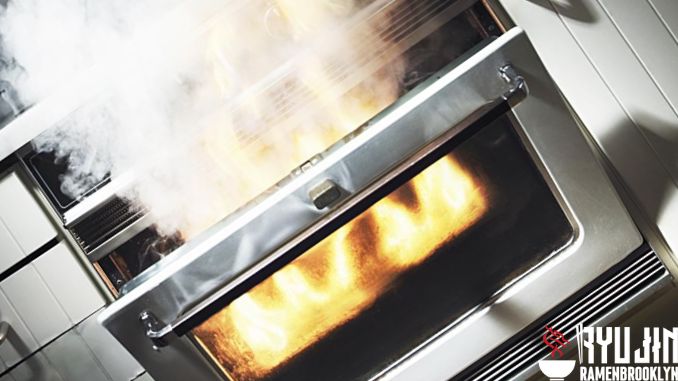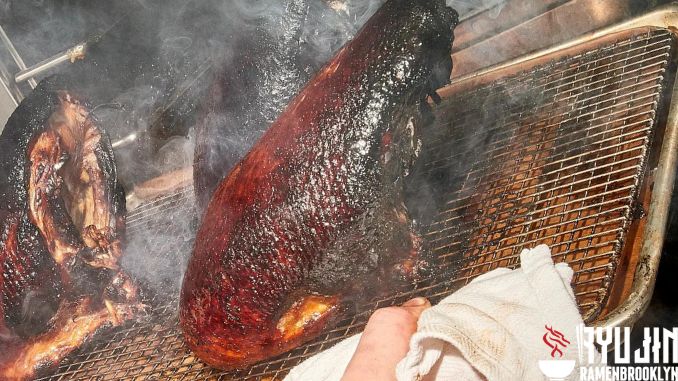Why is My Oven Smoking?
Over recent days, my oven has been giving off a smoky smell while in use but is working normally otherwise. Why does it smoke? And should I ignore this or take action to stop the problem from getting worse before taking care of business on your end as well?
If you’ve ever walked into your kitchen and noticed a cloud of smoke coming from your oven, you’re not alone. This is a common problem that many homeowners face, but what causes it and how can you fix it?
The smoke signals coming out of your oven might be sending a message to you. What does it mean? Why is there so much black, billowing cloud in the first place and how can we avoid having another one like this in our home or business?
The smoke from your oven can be a serious danger and should not go ignored. In fact, if you’re concerned that life or property is in danger then call 911 immediately! But for those who have more investigating to do before they make such decisions, there are some possible causes as well which we will explore below so keep reading
If your oven is smoking, it’s important to identify the source of the smoke as soon as possible. In some cases, it may be a harmless issue that can easily be fixed. However, in other cases, it could be a sign of a more serious problem. By identifying and fixing the source of the smoke quickly, you can avoid potential damage to your oven or even a house fire.
In this blog post, we’ll explore some of the reasons why your oven might be smoking, and we’ll provide tips on how to prevent it from happening again. Keep reading to learn more.
See more: How to Turn on an Oven
Why is My Oven Smoking? What to Do When Your Oven Is Smoking?
Ignoring the smoke coming from your oven can have serious consequences. For one thing, it may reduce how well food cooks and tastes—even if you didn’t notice any difference when cooking for yourself last time around! The worst-case scenario is that this could irritate people with respiratory conditions or signal an impending failure in some other aspect of home appliance operation like fire alarms going off due to too much heat buildup inside. But even at lower levels (light haze), these are still bad news signs because more than likely there will be lasting effects on both human health and animal noses alike if this keeps happening day in and out.
No matter what type of oven you have, it’s not altogether uncommon to experience some degree of smoke coming out. In new or old units; electric and gas appliances with food inside them like refrigerators-even when operating in preheat mode!
The problem can be caused by many different factors including a clogged venting system that’s causing too much humidity inside your home as well excessive loading on single mesh filters at exhaust fans located near where cooking occurs (this is common for professional kitchens).
In the event you are experiencing a smoking oven, don’t waste time feeling discouraged! It can be caused by many different factors and there’s always hope for an easy fix.
Burn off factory coatings
Heating elements in most modern ovens produce smoke as they burn off an oil-based factory coating, but this is normal and should be ignored. If you see black or brown dust coming out of your new appliance when it’s first used for 30 minutes then there may still be some residue left on the element from its manufacturing process which can lend a burnt taste to food cooked within that won’t please everyone’s palate!
If you want to burn in your oven, make sure it’s turned off when not using, and let cool completely before removing any pots or pans from the rack. Once cooled down (and without smoke!), set to “bake” at manufacturer-recommended temperature for the amount of time as desired- usually between 400 – 600 degrees Fahrenheit! This should be done with the door open so you can keep an eye on things, and it’s best to place a pan of water on the lowest rack to help with the burning process.
After allowing the oven to preheat for 30 minutes or as directed, turn it off and let it cool before using it as usual. If there’s still an odor or if food continues to taste burnt, run through this cycle again until it subsides.
Remove baked-on food remains
You should always be careful when using an old, used oven that has been smoked. If you regularly broil high-fat foods like steaks or bake pizzas directly on the racks without a baking sheet underneath, grease can splatter onto the roof and sidewalls of the oven which could result in a fire as well! Grease from cooked meats gets hard after a while so it’s important to clean these up while they’re still wet before putting out any more smoke for safety reasons.
Make sure you clean out all the stains and dirt from the inside before cooking. If not, then these remains can harden while they’re still wet which will result in an unpleasant smell when cooking again later on! You might also have problems with burning or even fire emissions if left unchecked- don’t take chances; use this time wisely by cleaning up as soon as possible after finishing work for the day.
If you want to remove baked-on food remains, make a solution of one part water to two parts baking soda and apply it liberally with a sponge or cloth onto the soiled areas. Let this sit for about 15 minutes before wiping away and rinsing with clear water to get rid of any lingering residue. You might need to put in some elbow grease if there are big chunks or caked-on bits, but overall this should be an easy process that doesn’t take too long.
This is a great tip to prevent the oven from smoking and getting dirty. To do this, turn off your appliance then open up its door carefully so as not to break any glass bottles inside! Once everything’s cool enough for you (about 10 minutes), clean away all large food chunks with plastic tongs before cleaning manually using natural agents such as white vinegar or baking soda-water mixtures; just make sure it doesn’t contain chemicals because those could damage painted surfaces too much.
If you have a self-cleaning oven then run it through a cycle according to the manufacturer’s instructions; this will help loosen anything that’s been stuck on for a while and make removal much easier afterward.
If you need more help, there are plenty of online guides and how-to videos available on the internet to give step-by-step instructions for cleaning an oven. Just be sure to unplug the unit first and take all necessary safety precautions before starting any project!
See more: How to Unlock Oven Door
Wipe up cleaner residue
If you recently cleaned your appliance with a commercial cleaning solvent but now see that the oven is smoking, it’s likely due to leftover ingredients burning off and producing fumes which may result in an unpleasant smell for those living nearby or near its source – especially if they are sensitive towards these types of substances!
To remove any lingering residue, simply wipe down the interior surfaces with a damp cloth before using it as usual. If there’s still an odor or if food continues to taste burnt, run through this cycle again until it subsides. You might also want to try opening up all the windows and doors in your home to air things out while the oven is running on its highest setting for 30 minutes with the door open; just be sure to keep an eye on things so that nothing catches fire!
To keep your oven in peak condition, don’t use chemical cleaners, and make sure you turn off the heat before cleaning. To avoid possible damage from overheating or sudden temperature changes when using a water-dampened rag for wiping up spills—especially if they’re oil-based like olive oil!–and also ensuring that there isn’t any cleaner residue left behind on these surfaces which could lead to corrosion later down the line because of how easily it likes ironing out dirt particles!
Run short self-clean cycles in pre-washed ovens
When you put food in your oven, it cooks and smokes! But not always. If the smoke comes only during self-clean cycles then there may be an issue with how hot this part of the machine gets because when we turn off our kitchens to prevent excessive heat buildup that can create toxic fumes or other problems like fire hazards (don’t forget about safe practices!). It’s best if we let them cool completely before wiping down interior surfaces using water-dampened rags so as not to continue cooking at shorter durations than necessary.
If you have a self-cleaning oven, it’s important to remember that these should be run on the short cycle setting and not the long one! Doing so will prevent any damage from occurring due to extended periods of the high heat as well as save you time and energy in the long run.
To clean an oven with this feature, simply remove all loose food debris and dirt accumulation from the surface using a damp cloth or sponge. Once everything has been cleared away, set the timer for no more than two hours before starting the cycle—this will give the unit enough time to do its job without putting unnecessary strain on its internal components.
Once the cycle is finished, allow things to cool down before opening up the door and wiping away any ashes that may have been left behind with a clean, dry cloth. And that’s it! Your oven will now be sparkling clean and ready for use once again.
Replace faulty heating elements
When you see smoke coming out of your oven during a self-clean cycle, it may be an indication that there is excessive heat buildup and one or more heating elements will soon fail as result. This usually happens because they become too hot for long periods of time which causes them to buzz loudly before destruction occurs altogether! These parts will short-circuit and buzz before failure–so watch for those warning signs!
The easiest way to know if your heating elements are working properly is by turning off the oven and then switching it back on. If one of them doesn’t glow in red while operating at “bake” or “broil” modes, then that may be an indication that you need new ones installed because they’re not doing their job properly which could lead to other problems such as smoke pollution outside during summertime when there are high humidity levels combined with burning wood smells coming from your oven!
Installing new heating elements is a relatively easy task that can be completed in a few minutes with just a few tools. Simply unscrew the old ones and screw in the new ones making sure that they’re tight before turning on the power to test them out. If everything looks good, then you’re all set!
The first thing you need to do when your oven breaks are cut the power from its breaker box and unplug it. Afterward, remove any screws or rails that connect between elements inside of cabinets with a screwdriver before detaching one side (depending on the type) so they can be replaced easily later if needed by simply unbending metal prongs attached at each end–these are called tabs; then just slide out whatever kind matches yours perfectly! Professional replacements will run about $60-$130 while DIY ones usually cost less than half this amount – around 15 dollars for parts alone but the labor could vary depending upon the skill level required.
A great rule-of-thumb before buying anything replacement-related: does this device create heat? It should! If not, it may be time to replace your heating element. Heating elements are responsible for creating the heat that cooks your food.
If you find that your oven is no longer cooking food properly, it could be due to a faulty heating element. You can test the element by turning off the power to the oven and then testing it with a continuity tester. If there is no continuity, then the element needs to be replaced.
If you have an electric oven, there are two elements: one at the bottom of the oven and one at the top. If you have a gas oven, there is only one element located at the bottom of the oven. You can purchase a replacement heating element from most hardware stores or appliance stores. Be sure to take the old element with you to ensure that you get the correct replacement.
Once you have the new element, follow these instructions to replace it:
- Turn off the power to the oven at the circuit breaker or fuse box.
- Remove the racks from the oven.
- Remove the back panel of the oven to access the heating element.
- Disconnect the wires from the element and then remove the screws that hold it in place.
- Install the new element by screwing it into place and then reconnecting the wires.
- Replace the back panel of the oven and turn on the power at the circuit breaker or fuse box.
Test the oven to ensure that it is working properly. If your oven is still smoking after you have replaced the heating element, there may be another issue that needs to be addressed. Try cleaning the oven as described above and if that does not resolve the problem, you may need to call a qualified repair person to take a look at your oven.
Reduce gas pressure
The gas oven is a great choice for those who live in homes with natural gas lines, but it can be risky if you don’t know how to use your new appliance. The high pressure from an improperly converted device could cause tall flames and smoke while cooking – which would not only make things harder on yourself financially (although that may not matter much), but It’s also dangerous because there’ll likely already exist enough flame before reaching these towering heights that any small spark will instantaneously turn into something big!
The gas ovens are typically converted from using natural gas to propane, which can lead to them having a higher pressure. When converting an old oven from natural gas to liquid propane, it’s important that the conversion process is done properly and without any leaks. If there are problems during this phase of usage then high volumes of smoke may result due to dangerous flames meeting or exceeding heights on racks within your home’s kitchen area as well as possible fires occurring while you’re cooking!
If you believe that your oven is smoking because of an incorrect conversion, the first thing you should do is turn off the power and gas. Next, check all of the connections to make sure they’re tight before relighting the pilot light. If the problem persists, call a qualified technician to take a look at your oven. Over time, various parts in your oven will need to be replaced as they wear out. This is especially common with heating elements, which are responsible for creating the heat that cooks your food.
If you don’t know what to do or need help, then consult an experienced professional for conversion adjustments. You should also get in touch with your gas company since they may have the proper tools that can reduce this risk safely!
Properly use and maintain your oven
The easiest way to keep your oven smoke-free is by using a pan before cooking. This will prevent any spills from coming in contact with the hot surfaces of equipment and can also help you avoid burning yourself when pulling out dishes after use! Place food in baking or broiling pans before starting any dish that goes inside the hottest part (like most griddles); avoid placing items directly onto hot racks.
If you have an oven with multiple racks, food on the upper rack can drip down and ruin your oven’s clean surface. To prevent this, put a fireproof mat at bottom of the lowest tier to catch any messes that might happen! Always remember to clean up any spills immediately after cooking because they will be harder to remove once the oven has cooled down.
Another preventative measure is to keep the area around your oven clean. Any crumbs or grease that falls on the floor can be a fire hazard, so make sure to sweep up regularly. You should also clean the inside of your oven on a regular basis to prevent burnt-on food from smokey smells and dangerous flare-ups. If you do notice that your oven is smoking more than usual, there are a few things you can do to try and fix the problem.
You should always maintain a clearance of at least three inches between food and heating elements in an electric oven. If you place them any closer, the foods will readily smoke or catch fire! When using a gas oven, make sure that there is enough space between the food and the main burner at bottom of your appliance as well as the broiler on top of the oven.
Cleaning your oven is one of the best ways to keep it in top shape. Use a damp cloth or paper towels and wipe down any wet food from its interior surfaces, racks as well as outside door glasses before cleaning with soap & water-free products that are designed for this type of appliance. You should also remove the racks from your oven and clean them in hot, soapy water.
If you have a self-cleaning oven, be sure to follow the manufacturer’s instructions carefully. These types of appliances reach very high temperatures that can cause a lot of smoke, so it’s important to open all the windows and turn on any exhaust fans before starting the cycle.
It’s also important that you regularly maintain your oven by cleaning it on a regular basis. At least once a month, give your appliance thorough cleaning with soapy water and a scrub brush – paying special attention to the door seal. Once a year, you should also descale the inside surfaces (including racks) to prevent the build-up of tough grime that’s harder to remove. If you follow these tips, then you’ll be less likely to see smoke or other problems while using your oven.
You should also be careful when cooking smoky foods like bacon or sausage as these can cause a build-up of grease which could eventually lead to a dangerous fire hazard if not cleaned on a regular basis. Always keep an eye on what you’re cooking and make sure to turn on the range hood vent to help with smoke removal.
If you have any concerns, it’s always best to contact a professional for help or advice before continuing with any cleaning project. They’ll be able to identify the cause of the problem and offer solutions that are tailored specifically to your oven model and situation.
See more: 10 Common Oven Problems and How to Fix Them
Why Do Older Ovens Smoke?
Of course, if you’ve had your oven for a while it’s possible that there may be some burning grease or food particles trapped in the unit. This is because of how many times cooking with an uncovered meat dish can cause unwanted liquids and ash to accumulate along its walls over time!
The smoke pouring out of your oven is an indication that you need to clean it. Oftentimes, these unwanted liquids and particles get trapped in cooking meat or fish with high-fat content as well as items such as pizza doughs which are cooked on top but not below because they’re frozen before being placed inside for baking. French fries also go through this process so their crispy exterior has nothing holding them together once fried!
Because of this, it’s really important to make sure that you give your oven a good cleaning at least once every few months – even if you don’t see any evidence of smoking. Not only will this help keep your food tasting great, but it’ll also prevent any potential fires from happening in the first place. If you suspect that there is already something burning inside your oven, then you should immediately turn off the power at the circuit breaker and call a professional for help.
The smoke & fire danger of cooking without cover. A lot can go wrong when you don’t use a lid for your oven, from trapping unwanted liquids to generating unnecessary smoke. Uncovering food as it cooks will allow any grease or particles on its surface to be burned off by airflow—a much safer method than using an open flame!
Your oven could be on fire! This is a situation that many people will never experience, but it’s always best to be safe than sorry. If you notice smoke coming out of your kitchen after performing a routine cooking task like baking cookies or frying bacon.
Then chances are there has been some sort of malfunction with either the heating elements in question (which can cause overheating) as well excessive grease build up inside this important appliance which hazards flames and eventually leads them everywhere–including near vital areas where human lives depend upon respiratory functions going unchecked until too late!
So, if you ever find yourself in this dangerous predicament; make sure to turn off the power at the circuit breaker and call a professional for help right away. Do not try to put out the fire with water as this will only spread the flames and could cause serious injury. When it comes to your oven, smoking is never a good sign.
It usually indicates that there’s something wrong – whether it’s a build-up of grease or food particles, or a problem with the heating elements. If you’re ever concerned about smoke coming from your oven, it’s best to turn off the power and call a professional for help. With their expertise, they’ll be able to identify the cause of the problem and offer solutions that are tailored specifically to your oven model and situation.
How Do I Stop My Oven from Smoking When Cooking?
There are a few things you can do to prevent your oven from smoking when cooking:
– Make sure that the oven is clean before use. A build-up of grease and food particles can cause smoke.
– Use a lid when cooking. This will help to prevent any grease or food particles from burning off.
– Avoid overcrowding the oven. Cooking multiple items at once can cause smoke.
– Keep an eye on the food as it cooks. If you see any signs of smoke, turn off the oven and call a professional for help.
Conclusion
The smokey oven is a problem that many homeowners deal with. It’s because there are so many potential causes for this, such as burning food particles or even faulty heating elements in your stovetop! The first step you should take when trying to solve the issue would be analyzing what might have caused it through an inspection of all components involved – from top-to-bottom and side-to-sides alike; then fixing anything wrong accordingly (or if nothing needs correcting).
For a perfect smoke-free kitchen, place high-fat foods at least three inches away from the broiling element and baking unit. Avoid using chemical solutions as they will leave residues that could start fires or produce more harmful chemicals when heated. Instead, clean with soapy water and a scrub brush – taking extra care to remove any burnt-on food from the inside surfaces, racks as well as outside door glasses.
The high pressure from a gas oven’s valves is what causes it to smoke until its factory oil coating burns away. Newer models tend not to have this problem as much because they don’t need time for their systems and components to wear in, but if yours has been running slow or exhibits any other signs of distress you should take drastic measures such as switching off the power immediately!
The worst thing that can happen if you don’t take care of your oven is burning its contents. But this will only happen in the case where there are no safety mechanisms to prevent it from happening (i e high pressure released). It also depends on what type/age/model number etc., but usually these should last for 10 years before needing servicing!
After that, make sure you’re cleaning your oven on a regular basis – at least once a month – using soapy water and a scrub brush to get rid of any built-up grease or food particles that could create problems down the line. If you still can’t seem to figure out why your oven is smoking, then it might be time to call in a professional for help.
Now, you have it! Why is my oven smoking and how you can fix the problem? Just remember to take all the proper precautions, use common sense, and take care of your appliance on a regular basis and you’ll be fine! Don’t forget to check out other articles on our website for more home improvement tips and tricks.
Anthony Michelin (March 26, 1960) is the CEO of Ryujinramenbrooklyn.com – is an expert in finding specialized equipment to assist in the Bar & Kitchen sector. With over 40 years of focus on finding the simplest recipes on the most suitable cookware to create the most delicious meals, I believe it will help you.
